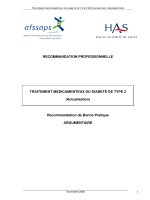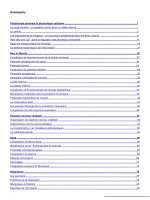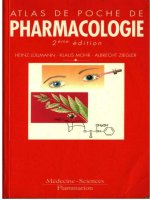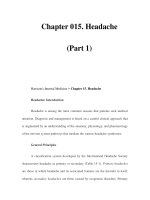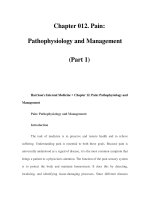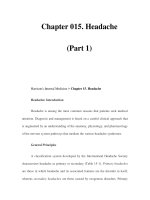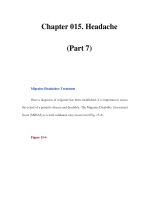Chapter 043. Jaundice (Part 1) pptx
Bạn đang xem bản rút gọn của tài liệu. Xem và tải ngay bản đầy đủ của tài liệu tại đây (85.87 KB, 5 trang )
Chapter 043. Jaundice
(Part 1)
Harrison's Internal Medicine > Chapter 43. Jaundice
Jaundice: Introduction
Jaundice, or icterus, is a yellowish discoloration of tissue resulting from the
deposition of bilirubin. Tissue deposition of bilirubin occurs only in the presence
of serum hyperbilirubinemia and is a sign of either liver disease or, less often, a
hemolytic disorder. The degree of serum bilirubin elevation can be estimated by
physical examination. Slight increases in serum bilirubin are best detected by
examining the sclerae, which have a particular affinity for bilirubin due to their
high elastin content. The presence of scleral icterus indicates a serum bilirubin of
at least 51 µmol/L (3.0 mg/dL). The ability to detect scleral icterus is made more
difficult if the examining room has fluorescent lighting. If the examiner suspects
scleral icterus, a second place to examine is underneath the tongue. As serum
bilirubin levels rise, the skin will eventually become yellow in light-skinned
patients and even green if the process is long-standing; the green color is produced
by oxidation of bilirubin to biliverdin.
The differential diagnosis for yellowing of the skin is limited. In addition to
jaundice, it includes carotenoderma, the use of the drug quinacrine, and excessive
exposure to phenols. Carotenoderma is the yellow color imparted to the skin by
the presence of carotene; it occurs in healthy individuals who ingest excessive
amounts of vegetables and fruits that contain carotene, such as carrots, leafy
vegetables, squash, peaches, and oranges. Unlike jaundice, where the yellow
coloration of the skin is uniformly distributed over the body, in carotenoderma the
pigment is concentrated on the palms, soles, forehead, and nasolabial folds.
Carotenoderma can be distinguished from jaundice by the sparing of the sclerae.
Quinacrine causes a yellow discoloration of the skin in 4–37% of patients treated
with it. Unlike carotene, quinacrine can cause discoloration of the sclerae.
Another sensitive indicator of increased serum bilirubin is darkening of the
urine, which is due to the renal excretion of conjugated bilirubin. Patients often
describe their urine as tea or cola colored. Bilirubinuria indicates an elevation of
the direct serum bilirubin fraction and therefore the presence of liver disease.
Increased serum bilirubin levels occur when an imbalance exists between
bilirubin production and clearance. A logical evaluation of the patient who is
jaundiced requires an understanding of bilirubin production and metabolism.
Production and Metabolism of Bilirubin
(See also Chap. 297)
Bilirubin, a tetrapyrrole pigment, is a breakdown product of heme
(ferroprotoporphyrin IX). About 70–80% of the 250–300 mg of bilirubin produced
each day is derived from the breakdown of hemoglobin in senescent red blood
cells. The remainder comes from prematurely destroyed erythroid cells in bone
marrow and from the turnover of hemoproteins such as myoglobin and
cytochromes found in tissues throughout the body.
The formation of bilirubin occurs in reticuloendothelial cells, primarily in
the spleen and liver. The first reaction, catalyzed by the microsomal enzyme heme
oxygenase, oxidatively cleaves the α bridge of the porphyrin group and opens the
heme ring. The end products of this reaction are biliverdin, carbon monoxide, and
iron. The second reaction, catalyzed by the cytosolic enzyme biliverdin reductase,
reduces the central methylene bridge of biliverdin and converts it to bilirubin.
Bilirubin formed in the reticuloendothelial cells is virtually insoluble in water.
This is due to tight internal hydrogen bonding between the water-soluble moieties
of bilirubin, proprionic acid carboxyl groups of one dipyrrolic half of the molecule
with the imino and lactam groups of the opposite half. This configuration blocks
solvent access to the polar residues of bilirubin and places the hydrophobic
residues on the outside. To be transported in blood, bilirubin must be solubilized.
This is accomplished by its reversible, noncovalent binding to albumin.
Unconjugated bilirubin bound to albumin is transported to the liver, where it, but
not the albumin, is taken up by hepatocytes via a process that at least partly
involves carrier-mediated membrane transport. No specific bilirubin transporter
has yet been identified (Chap. 297, Fig. 297-1).
After entering the hepatocyte, unconjugated bilirubin is bound to the
cytosolic protein ligandin, or glutathione S-transferase B. Whereas ligandin was
initially thought to be a transport protein, responsible for delivering unconjugated
bilirubin from the plasma membrane to the endoplasmic reticulum, it now appears
that its role may in fact be to reduce bilirubin efflux back into the plasma. Studies
suggest that unconjugated bilirubin may well rapidly diffuse unaided through the
aqueous cytosol between membranes. In the endoplasmic reticulum, bilirubin is
solubilized by conjugation to glucuronic acid, a process that disrupts the internal
hydrogen bonds and yields bilirubin monoglucuronide and diglucuronide. The
conjugation of glucuronic acid to bilirubin is catalyzed by bilirubin uridine
diphosphate-glucuronosyl transferase (UDPGT). The now hydrophilic bilirubin
conjugates diffuse from the endoplasmic reticulum to the canalicular membrane,
where bilirubin monoglucuronide and diglucuronide are actively transported into
canalicular bile by an energy-dependent mechanism involving the multiple drug
resistance protein 2.
The conjugated bilirubin excreted into bile drains into the duodenum and
passes unchanged through the proximal small bowel. Conjugated bilirubin is not
taken up by the intestinal mucosa. When the conjugated bilirubin reaches the distal
ileum and colon, it is hydrolyzed to unconjugated bilirubin by bacterial β-
glucuronidases. The unconjugated bilirubin is reduced by normal gut bacteria to
form a group of colorless tetrapyrroles called urobilinogens. About 80–90% of
these products are excreted in feces, either unchanged or oxidized to orange
derivatives called urobilins. The remaining 10–20% of the urobilinogens are
passively absorbed, enter the portal venous blood, and are reexcreted by the liver.
A small fraction (usually <3 mg/dL) escapes hepatic uptake, filters across the renal
glomerulus, and is excreted in urine.

